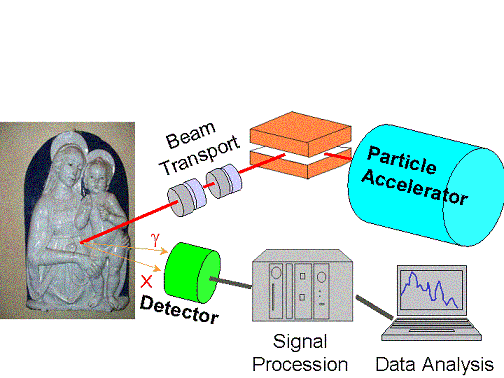Sezione di Genova
Universita' di Genova
|
|
ISTITUTO NAZIONALE DI FISICA NUCLEARE
Sezione di Genova |
DIPARTIMENTO DI FISICA
Universita' di Genova |
|
X-Fluorescence Techniques
XRF TecniqueXRF is a spectrometric tecnique used to measure the elemental composition of a sample in no destructive way. Atoms emit monocromatic electromagnetic radiation (X rays) when they return to the ground state after excitation induced by charged particles and/or X rays (XRF).
XRF uses a primary beam of X rays, produced by a Coolidge tube, to induce secondary fluorescence, detected and analysed by silicon detector.
Ion Beam Analysis Tecnique
Ion Beam Analysis (IBA) techniques are based on nuclear or atomic reactions of known cross section triggered when an unknown targhet is irradiated a particle beam. By analyzing the reaction products (particles g and/or X radiation), it is possible to deduce the elemental composition of the irradiated sample. Incoming particles may come from radioactive sources, but electrostatic accelerators (Van der Graaf, Tandem) with a terminal energy between 2 and 6 MeV are prefered because the higher fluxer. Several IBA techniques have been developed, among them: PIXE and PIGE, which employ respectively X and g ray emission from the sample, RBS (Rutherford Backscattering Spectrometry), where the backscattered primary ions are analyzed, and NRA (Nuclear Reaction Analysis) where particles ejected in nuclear processes can be analyzed. In figure 1 the layout of an experimental setup for IBA analysis is schematically shown.

In PIXE (Particle-Induced X-ray Emission) charged particles interact with the electron cloud of an atom creating electronic holes in the inner shells (K, L, M), whose mean life ranges from 10 -9 to 10-16 seconds. Holes are eventually filled by outermost electrons and the residual energy, equal to the difference between the binding energies of the electron in the outer and in the inner shell, is normally emitted as X radiation or Auger electron. The energy of the X radiation is typical of the emitting element, and it is possible to deduce the target composition, as well as their concentration, through a measurement of the energy and of the intensity of the emitted X rays. Each sample produces a typical energy spectrum, like the one shown in figure 2.

PIXE is used in many fields ( Archeometry, Environment, Biology... ) thanks to some peculiar features. PIXE in fact is a technique:
The main limitation of PIXE is due to the high absorption coefficient for X rays produced by light elements (Z<11), which makes them undetectable; moreover, the depth analysis is limited by the range of protons in matter (3 MeV protons, usually used in PIXE, penetrate in materials only for a few tens of mm). The use of PIXE together with other nuclear techniques (RBS, PIGE) very often allows an analysis all over the periodic table of elements.
|
|
HOME |